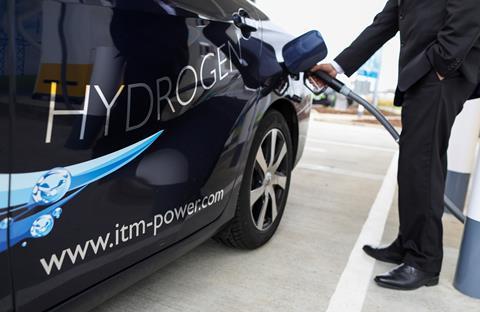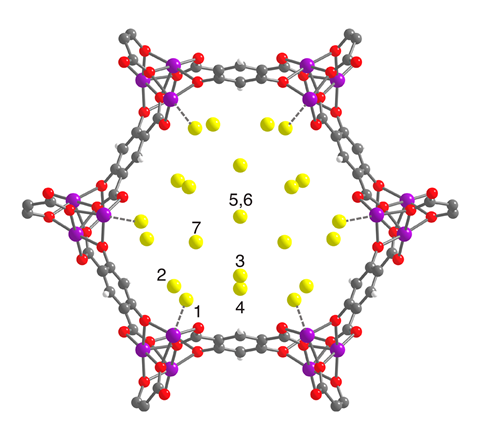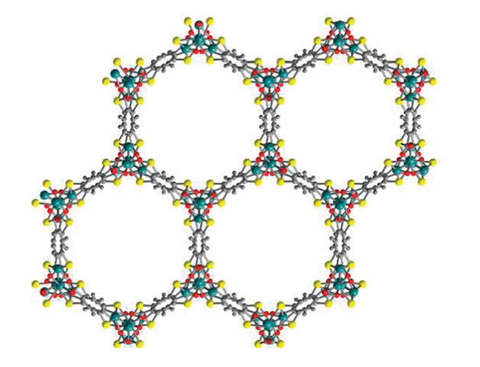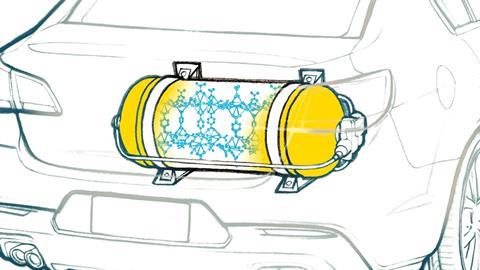As production costs fall and demand is poised to rocket, James Mitchell Crow finds the hydrogen economy is finally ready for take-off – as long as we can find ways to store it
Japan has an ambitious plan to transform its energy system. But to pull it off, it is going to need a lot of hydrogen.
Japan wants to quit fossil fuels and import clean hydrogen to meet its energy needs instead. In December 2017, its Ministry of Economy, Trade and Industry published a roadmap laying out how it intends to gradually drive up demand, and so drive down costs, until clean hydrogen becomes cost-competitive with natural gas.
For the plan to succeed – and similar plans in hydrogen hotspots such as California – chemistry is going to be key.
Supply and demand
Hydrogen’s simple appeal as a fuel is that when burned, or consumed in a fuel cell to generate electricity, the only emission is water vapour. No NOx, SOx, CO2 or particulates. Electrochemist John Bockris coined the phrase ‘hydrogen economy’ in a 1970 speech to General Motors – but even then, the concept of using renewable electricity to electrolytically split water molecules and release hydrogen was nothing new. The idea has been examined regularly over the years, but the economics have never stacked up.

Things are different this time, says Craig Buckley from Curtin University in Perth, Australia, who has been in hydrogen storage research since 1988 and has seen interest in hydrogen wax and wane several times. ‘This time, all the stars seem to be lining up,’ he says.
One key factor is the steadily plummeting price of renewable electricity, the single biggest cost for electrolytic hydrogen production. Since 2010, the price of electricity from wind has fallen 50%, while solar electricity has fallen 80%. ‘Renewable energy has come so far down in price, [hydrogen production] can be competitive with fossil fuels. This has been a bit of a game changer,’ Buckley says.
‘What’s also happened in the last year or two is Japan and South East Asia have made a big move, saying they want to become a hydrogen economy,’ he adds. ‘So there is a market now.’
Following the 2011 Fukushima nuclear accident, and the subsequent shutdown of all its nuclear power plants, Japan now relies on fossil fuel imports for 94% of its energy needs. But under the 2015 UN Paris Agreement on climate change, Japan has committed to cut its carbon emissions by 26% by 2030 (from a 2013 baseline) and by 80% by 2050. The country does not have the available space or sunshine to produce enough renewable energy on its own. Imported hydrogen – whether produced electrolytically from renewables, or from fossil fuels with carbon capture – is its fuel of choice. Other energy importers in the region, including South Korea, have reached the same conclusion – while countries with plentiful renewable energy resources, from Australia to the Middle East and North Africa to Norway, are eying a new export opportunity.
Clean cars and sticky MOFs
By 2030, Japan wants to have 800,000 hydrogen powered fuel cell cars on the road. California, which already has almost 5000 of them on the road, has similar ambitions.
The challenge with hydrogen as a transport fuel – and with storing and transporting hydrogen in general – is that it is an extremely light, low-density gas. If a fuel cell car were to use atmospheric pressure to store the 1kg of hydrogen needed to drive 100km, the fuel tank would have to be 11m3 in size. So today’s fuel cell cars use compressed hydrogen gas, squeezing about 5kg into a 700 bar carbon fibre reinforced tank.

From one perspective, the technical challenge of creating a fuel tank for hydrogen passenger cars is therefore solved, says Buckley. But high pressure tanks are far from ideal, says Jeffrey Long, who researches hydrogen storage as part of his work on metal organic framework (MOF) materials at the University of California, Berkeley, US. ‘It means you have to use a heavy, awkwardly shaped, expensive fuel container. It also means you have to use a lot of energy to compress the gas,’ Long says. ‘Our goal is to create an adsorbent that will allow us to get a similar capacity, but at a maximum pressure of 100 bar.’ At that pressure, light-weight, inexpensive, conformable pressure vessels could be used in the car – and the energy penalty for compressing the hydrogen would also be slashed.
Long is part of a US Department of Energy (DoE) research consortium called HyMARC, which involves five DoE national laboratories as well as external labs such as his. The consortium aims to tackle some of the fundamental underlying challenges involved in hydrogen storage, says Mark Allendorf at Sandia National Laboratory, HyMARC co-director*. Up until 2010, the DoE poured a lot of dollars into trying to discover hydrogen storage materials that would meet certain targets – which have still not yet been met, Allendorf says. ‘Instead of taking that route further, they decided to step back and try to solve some of these problems, and relegate high-risk high-payoff materials discovery to smaller projects that have very strict go/no go targets they have to meet to progress.’
According to calculations, the magic number researchers need to reach to get good reversible room temperature hydrogen storage, at a maximum 100 bar of pressure, is hydrogen adsorption energy of 15–20kJ/mol. The two main classes of solid-state hydrogen storage materials sit either side of that number. Metal hydrides, and related materials that take up hydrogen via chemical bond formation, bind hydrogen too strongly and have to be heated to drive the hydrogen off, whereas porous absorbents such as MOFs bind hydrogen too weakly to hold enough of it. ‘The energy range of 15–20kJ/mol is one where we don’t have a lot of examples of how to do that,’ Long says.
The problem for physical adsorption it that hydrogen does not like to stick to things. ‘You are generally using a polarisation effect to get the molecule to stick to the surface – but hydrogen has just two electrons to push around, so it is very difficult to polarise,’ Long says.

Long’s lab has been making their MOFs ‘stickier’ by adding low-coordinate metal cation sites into the MOF. His team has created MOFs in the right binding energy ballpark – but hit another problem.1 ‘Using metal cations is relatively heavy,’ Long says, which means these materials don’t hold enough hydrogen relative to their weight. ‘So we are trying to create MOFs that have low-coordinate metal cations that can interact with two, three or even four hydrogen molecules per cation, reversibly in the 15–20kJ/mol range.’

The team has created manganese-based MOFs that will hold two hydrogen atoms per metal cation – but below the 15kJ/mol minimum.2 ‘We are working on bringing these things together,’ Long says. Magnesium- or calcium-based structures have the potential to tick both boxes, calculations suggest. ‘But synthetically it has been a huge challenge to create these co-ordinately unsaturated metal cations on the surfaces within a MOF.’
Back and forth
Allendorf has also been investigating MOFs, but with a different strategy. He’s using them as host materials for metal hydrides nanoparticles.
Researchers in the 1970s identified a range of bulk hydrogen storage materials, mainly based on metals and metal alloys, that have a room temperature hydrogen storage capacity of around 2% by weight, says Kondo-Francois Aguey-Zinsou from the University of New South Wales in Sydney, Australia. For certain applications, that level of performance is perfectly acceptable, he says. Aguey-Zinsou recently launched a spin out company to use metal hydrides at the heart of a system for storing energy from household or commercial rooftop solar panels, to rival battery storage such as the Tesla Powerwall. The system would incorporate a small water-splitting electrolyser to generate hydrogen, and a fuel cell to release the energy. Compared to a lithium-ion battery, the system could potentially store a lot more energy for a similar footprint, and should have a working lifespan of about 30 years, which no battery could match, Aguey-Zinsou argues.
US company Power Plug has already commercialised hydrogen powered forklift trucks. For a forklift, which must carry a lot of ballast, a heavy fuel tank is no penalty. The forklifts use a nickel-aluminium alloy hydrogen storage material called Hy-Stor 208 in their fuel tanks.3 The forklifts can be refuelled in 15 minutes, a fraction of the time recharging a battery forklift takes.
But for broader applicability – for hydrogen-powered road vehicles and for hydrogen transport – better storage performance is needed. Augey-Zinsou is targeting a hydrogen storage capacity of 10% by weight. A range of materials do hold hydrogen in that target range – usually based on low-weight elements such as lithium, aluminium, boron, nitrogen or magnesium – but they invariably have problems, he says. ‘Usually they release hydrogen at very high temperature, and it is very hard to get the hydrogen back in to the material, so you need very high pressure,’ he says.
The way forward is to nanosize the materials, Augey-Zinsou says. ‘We think by doing that we will be able to control the binding strength of hydrogen.’ That way, high temperatures and pressures can be avoided. The team is already making progress using this approach. Ammonia borane, with a hydrogen content of 19.6% by weight, is a promising hydrogen storage material – with the major drawback that hydrogen release is irreversible. ‘Despite the common thinking those materials will never reversibly store hydrogen, we can generate a compound that can reversibly store hydrogen,’ he says. The trick was to create 50nm ammonia borane particles within a nickel matrix.4 So far, the material reversibly stores just 1% hydrogen by weight, but it works at low temperatures and pressures.
Augey-Zinsou’s team is also taking the same approach with borohydride materials – as are Allendorf and his HyMARC colleagues with metal hydrides. ‘Typically, the problem is that they are too stable and you have to heat them up to get the hydrogen off,’ Allendorf says. But once shrunk to the single digit nanometre scale, there can be dramatic reductions in the activation energy for hydrogen release, he says. To stop the nanoparticles clumping together, the team has developed ways to embed them in the pores of MOFs or porous carbon. ‘That’s probably the way to go – porous carbon is very light and very cheap,’ he says. To minimise the amount of host material and maximise the number of hydrogen carrying nanoparticles, HyMARC partner Jeff Urban at Lawrence Berkeley National Lab in the US recently managed to wrap magnesium nanoparticles in graphene, carbon just a single layer of atoms thick.5
Looking to liquids

Hydrogen power could be an even better fit for trucks and buses than for cars. Larger vehicles can incorporate large tanks of hydrogen gas pressurised only to around 200 bar. And whereas hydrogen powered cars are likely to face stiff competition from battery energy storage, today’s batteries can’t hold enough energy per kilogram to power long distance trucking or all day bus travel. Hydrogen’s higher energy density, and rapid refuelling, is ideal for heavy vehicle use.
To transport bulk quantities of hydrogen, however – whether to supply refuelling stations, or to ship renewable hydrogen around the world – pressuring the gas is not going to work (see Chilling effects box). ‘Hydrogen is so light, you just can’t get enough of it into a high pressure tube trailer to come anywhere close to what’s going to be needed to supply a hydrogen refuelling station,’ Allendorf says.
When HyMARC’s funding was renewed in October 2018, the project’s research remit was expanded from focusing purely on passenger car hydrogen storage. ‘The area we have just started, hydrogen carriers, is focused on transporting hydrogen from one place to another,’ Allendorf says. ‘These are molecules that can bind hydrogen reversibly, at a high enough capacity that hydrogen transport is efficient.’ Methanol and ammonia are possible carrier molecules, he says.
Solid-state materials such as metal hydrides are still a possibility for large scale hydrogen transport, says Buckley. ‘Solid state may be a dark horse in terms of exporting hydrogen,’ he says. ‘But at the moment, the one that seems to be a frontrunner is ammonia.’
Chilling effects
Moving large amounts of hydrogen around doesn’t necessarily need a hydrogen storage material or chemical carrier. The alternative is to liquefy it, as is already done in huge scale to ship natural gas. ‘You want to transport hydrogen in the densest possible phase,’ says Øivind Wilhelmsen, who is researching hydrogen liquefaction at SINTEF Energy Research and the Norwegian University of Science and Technology in Trondheim. One boat of liquified hydrogen would contain the same amount of hydrogen as five boats of 200 bar hydrogen gas.
Whereas natural gas liquifies at about –162°C, however, hydrogen doesn’t liquefy until –253°C, only 20°C above absolute zero. Cooling that far currently takes a lot of energy, but there are many efficiencies to be found by overcoming the quantum effects that come into play at very low temperatures.
The dihydrogen molecule, with its two protons, can form two possible quantum spin isomers. In para hydrogen, the more stable form, the spin on the two protons is opposite; in ortho hydrogen, the spin is aligned. At room temperature, about 75% of dihydrogen is in the higher energy ortho state, but the equilibrium shifts as the temperature is lowered, until at –253°C, it is almost 100% para at equilibrium. ‘If you just cool down the room temperature equilibrium mixture, it is going to convert slowly in the tanks and release a lot of energy, and cause the hydrogen to evaporate very quickly,’ Wilhelmsen says. ‘It is a huge amount of energy you didn’t remove from the hydrogen.’
Catalysts in the heat exchanger used to liquefy the hydrogen can speed the ortho–para transition during cooling, but the ferric oxide catalyst currently used is quite slow. One option would be to use a faster catalyst such as a nickel compound. But Wilhelmsen has been researching an alternative approach; a spiral wound heat exchanger that cools the hydrogen more slowly, allowing more time for the catalyst to act.8
Wilhelmsen has also been investigating the refrigerants needed to cool the hydrogen to –253°C. At these low temperatures, the only coolants that won’t freeze out are hydrogen, helium and neon. ‘The challenge is, these fluids behave very strangely at cold temperatures, due to quantum effects. The particles behave more like a wave and the properties deviate from what you expect, so the equation of state for normal fluids don’t work.’
In collaboration with researchers at Imperial College London in the UK, Wilhelmsen and his colleagues have developed a new thermodynamic description for these very low temperature conditions. ‘We are going to put that into our modelling framework so we can design a tailor-made quantum fluid mixture that is going to work nicely with the compressor equipment,’ he says.
Currently, liquefying hydrogen takes 12kWh of power per kilo of hydrogen, equivalent to about 25% of the energy that hydrogen would release in a fuel cell. ‘Our target is to get is below 6kWh, a reduction of 50%,’ Wilhelmsen says. ‘I think that is within reach, we see a lot of avenues for progress.’
In Australia – currently the world’s biggest liquefied natural gas exporter, and the second biggest exporter of coal – ammonia is being eyed favourably as a way to export renewable hydrogen. Liquefied ammonia is a well-established industrial chemical, shipped at vast scale due to its use in fertiliser. If ammonia was produced from renewably generated hydrogen, rather than hydrogen from fossil fuels as is used today, it would make a carbon-free hydrogen carrier. Passing the ammonia over a hot catalyst gives a mixture of residual ammonia, nitrogen and hydrogen. Australia’s national research agency, CSIRO, recently demonstrated a membrane technology that uses selectively permeable tubes of palladium and vanadium to extract a stream of hydrogen pure enough to be fed directly into a fuel cell.6 But the technology is still to be demonstrated at scale – and the fact remains that ammonia produced by the Haber–Bosch process is very energy intensive to make. But there are many alternative hydrogen carriers out there.
In 2007, David Milstein at the Weizmann Institute of Science in Rehovot, Israel, published a new type of catalytic reaction: an amide bond formation, based on reactions of alcohols and amines under mild conditions.7 At the time, the motivation was purely an improved synthetic method for making amides. But the fact the reaction liberates hydrogen gas as a by-product suggested a new use for this chemistry. ‘We thought this might be useful for liquid organic hydrogen carriers,’ Milstein says.
The team tested the idea using ethanolamine, a molecule which incorporates an alcohol and an amine and reversibly releases hydrogen when reacting with itself. More recently, the team has used its ruthenium pincer catalysts to develop a related reaction, in which ethylene glycol oligomerises in an ester forming reaction to release hydrogen. ‘We are at the octamer stage, which releases 5.8wt% hydrogen, and we would like to get even higher,’ Milstein says. Ethylene glycol’s theoretical hydrogen storage capacity is 6.5wt%
Thanks to some delicately balanced thermodynamics, the same pincer catalyst can be used to release the hydrogen and regenerate the carrier without high temperatures and pressures. The next step is to immobilise the catalyst on a solid support, rather than have it dissolved in the reaction mixture. ‘Although, since we use the same catalyst for both directions, the liquid could contain the catalyst in it,’ Milstein says.
Which hydrogen storage modality will win out for different purposes remains an open question, says Milstein. ‘We need to go in all directions to find the best system,’ he says. ‘But developing fundamentally new catalytic reactions provides new opportunities, in synthesis and energy.’
‘It is important to remember that hydrogen storage technology has really come a long way,’ says Allendorf. ‘It has made its way into commercial use – maybe not in ways that are so visible to the consumer, but they are definitely out there.’
James Mitchell Crow is a science writer based in Melbourne, Australia
*The opinions expressed by Mark Allendorf are his own and do not necessarily represent the views of the US Department of Energy
References
1 M T Kapelewski et al, Chem. Mater., 2018, 30, 8179 (DOI: 10.1021/acs.chemmater.8b03276)
2 T Runčevski et al, Chem. Commun., 2016, 52, 8251 (DOI: 10.1039/C6CC02494G)
3 M V Lototskyy et al, Int. J. Hydrogen Energy, 2016, 41, 13831 (DOI: 10.1016/j.ijhydene.2016.01.148)
4 Q Lai et al, Adv. Sustainable. Syst., 2017, 2, 1700122 (DOI: 10.1002/adsu.201700122)
5 L F Wan et al, Chem. Mater., 2019, 31, 2960 (DOI: 10.1021/acs.chemmater.9b00494)
6 M D Dolan et al, J. Membr. Sci., 2018, 549, 306 (DOI: 10.1016/j.memsci.2017.12.031)
7 C Gunanathan et al, Science, 2007, 317, 790 (DOI: 10.1126/science.1145295)
8 Ø Wilhelmsen et al, Int. J. Hydrogen Energy, 2018, 43, 5033 (DOI: 10.1016/j.ijhydene.2018.01.094)













No comments yet